House of Nassau
| House of Nassau | |
|---|---|
|
Arms of Nassau: Azure billetty or, a lion rampant of the last armed and langued gules | |
| Country | Germany, Netherlands, England, Scotland, Ireland, Luxembourg, Nassau, Orange |
| Titles |
|
| Founded | 1093 |
| Founder | Dudo-Henry of Laurenburg |
| Current head | Willem-Alexander of the Netherlands |
| Dissolution | Since 1985 extinct in the original agnatic line |
| Cadet branches |
House of Nassau-Weilburg House of Orange-Nassau |
The House of Nassau is a diversified aristocratic dynasty in Europe. It is named after the lordship associated with Nassau Castle, located in present-day Nassau, Rhineland-Palatinate, Germany. The lords of Nassau were originally titled "Count of Nassau", then elevated to the princely class as "Princely Counts" (in German: gefürstete Grafen, i.e. Counts who are granted all legal and aristocratic privileges of a Prince).
At the end of the Holy Roman Empire and the Napoleonic Wars, they proclaimed themselves with the permission of the Congress of Vienna "Dukes of Nassau", forming the independent state Nassau (capital city: Wiesbaden), a territory which is at present mainly part of the German Federal State of Hesse (Hessen), and partially of the neighbouring State of Rhineland-Palatinate (Rheinland-Pfalz). The Duchy was annexed in 1866 after the Austrian-Prussian War as an ally of Austria by Prussia. It was subsequently incorporated into the newly created Prussian Province of Hesse-Nassau.
Today the term Nassau is used in Germany as a name for a geographical, historical and cultural region, but has no longer any political meaning. All Dutch and Luxembourgish monarchs since 1815 were senior members of the House of Nassau. However, in 1890 (for the Netherlands), respectively in 1912 (for Luxembourg), the male line of heirs to the two thrones became extinct, so that since then they descended in the female line from the House of Nassau.
According to German tradition, the family name is passed on only in the male line of succession. The House would be therefore, from this (German) perspective, extinct since 1985.[1][2] However, both Dutch and Luxembourgish monarchic traditions, constitutional rules and legislation in that matter differ from the German one, and thus both countries do not consider the House extinct. The Grand Duke of Luxembourg uses "Duke of Nassau" as his secondary title and a title of pretense to the dignity of Chief of the House of Nassau (being the most senior member of the eldest branch of the House), but not to lay any territorial claims to the former Duchy of Nassau which is now part of the Federal Republic of Germany.
Origins
Count Dudo-Henry of Laurenburg (ca. 1060 – ca. 1123) is considered the founder of the House of Nassau. He is first mentioned in the purported founding-charter of Maria Laach Abbey in 1093 (although many historians consider the document to be fabricated). The Castle Laurenburg, located a few kilometres upriver from Nassau on the Lahn, was the seat of his lordship. His family probably descended from the Lords of Lipporn. In 1159, Nassau Castle became the ruling seat, and the house is now named after this castle.
 Laurenburg Castle
Laurenburg Castle
The Counts of Laurenburg and Nassau expanded their authority under the brothers Robert (Ruprecht) I (1123–1154) and Arnold I of Laurenburg (1123–1148). Robert was the first person to call himself Count of Nassau, but the title was not confirmed until 1159, five years after Robert's death. Robert's son Walram I (1154–1198) was the first person to be legally titled Count of Nassau.
The chronology of the Counts of Laurenburg is not certain and the link between Robert I and Walram I is especially controversial. Also, some sources consider Gerhard, listed as co-Count of Laurenburg in 1148, to be the son of Robert I's brother, Arnold I.[3] However, Erich Brandenburg in his Die Nachkommen Karls des Großen states that it is most likely that Gerhard was Robert I's son, because Gerard was the name of Beatrix of Limburg's maternal grandfather.[4]
Counts of Laurenburg (ca. 1093–1159)
- ca. 1060 – ca. 1123: Dudo-Henry
- 1123–1154: Robert (Ruprecht) I - son of Dudo-Henry
- 1123–1148: Arnold I - son of Dudo-Henry
- 1148: Gerhard - son (probably) of Robert I
- 1151–1154: Arnold II - son of Robert I
- 1154–1159: Robert II - son of Robert I
Counts of Nassau (1159–1255)
- 1154–1198: Walram I - son of Robert I
- 1158–1167: Henry (Heinrich) I - son of Arnold I, died in Rome during the August 1167 epidemic (after the Battle of Monte Porzio)
- 1160–1191: Robert III, the Bellicose - son of Arnold I
- 1198–1247: Henry II, the Rich - son of Walram I
- 1198–1230: Robert IV - son of Walram I; from 1230–1240: Knight of the Teutonic Order
- 1247–1255: Otto I; from 1255–1289: Count of Nassau in Dillenburg, Hadamar, Siegen, Herborn and Beilstein
- 1249–1255: Walram II; from 1255–1276: Count of Nassau in Wiesbaden, Idstein, and Weilburg
In 1255, Henry II's sons, Walram II and Otto I, split the Nassau possessions. The descendants of Walram became known as the Walram Line, which became important in the Countship of Nassau and Luxembourg. The descendants of Otto became known as the Ottonian Line, which would inherit parts of Nassau, France and the Netherlands. Both lines would often themselves be divided over the next few centuries. In 1783, the heads of various branches of the House of Nassau sealed the Nassau Family Pact (Erbverein) to regulate future succession in their states, and to establish a dynastic hierarchy whereby the Prince of Orange-Nassau-Dietz was recognised as President of the House of Nassau.[5]
The Walram Line (1255–1985)

Counts of Nassau in Wiesbaden, Idstein, and Weilburg (1255–1344)
- 1255–1276: Walram II
- 1276–1298: Adolf of Nassau, crowned King of Germany in 1292
- 1298–1304: Robert VI of Nassau
- 1298–1324: Walram III, Count of Nassau in Wiesbaden, Idstein, and Weilnau
- 1298–1344: Gerlach I, Count of Nassau in Wiesbaden, Idstein, Weilburg, and Weilnau
After Gerlach's death, the possessions of the Walram line were divided into Nassau-Weilburg and Nassau-Wiesbaden-Idstein.
Nassau-Weilburg (1344–1816)

Count Walram II began the Countship of Nassau-Weilburg, which existed to 1816. The sovereigns of this house afterwards ruled the Duchy of Nassau until 1866 and from 1890 the Grand Duchy of Luxembourg. The branch of Nassau-Weilburg ultimately became rulers of Luxembourg. The Walram line received the lordship of Merenberg in 1328 and Saarbrücken (by marriage) in 1353.

 Weilburg Castle
Weilburg Castle East wing of the castle
East wing of the castle
Counts of Nassau-Weilburg (1344–1688)
- 1344–1371: John I
 Map of Nassau-Weilburg as of 1789
Map of Nassau-Weilburg as of 1789 - 1371–1429: Philipp I of Nassau-Weilburg, and (from 1381) Count of Saarbrücken
- 1429–1492: Philip II
- 1492–1523: Louis I
- 1523–1559: Philip III
- 1559–1593: Albert
- 1559–1602: Philip IV
- 1593–1625: Louis II, Count of Nassau-Weilburg and in Ottweiler, Saarbrücken, Wiesbaden, and Idstein
- 1625–1629: William Louis, John IV and Ernest Casimir
- 1629–1655: Ernest Casimir
- 1655–1675: Frederick
- 1675–1688: John Ernst
Princely counts of Nassau-Weilburg (1688–1816)
- 1688–1719: John Ernst
- 1719–1753: Charles August
- 1753–1788: Charles Christian
- 1788–1816: Frederick William
- 1816: Wilhelm, Prince of Nassau-Weilburg and Duke of Nassau — Nassau-Weilburg merged into Duchy of Nassau
Dukes of Nassau (1816–1866)
In 1866, Prussia annexed the Duchy of Nassau as the duke had been an ally of Austria in the Second Austro-Prussian War. In 1890, Duke Adolf would become Grand Duke Adolphe of Luxembourg.
Grand Dukes of Luxembourg (from the House of Nassau-Weilburg) - 1890–1912 and succession through a female onwards
- 1890–1905: Adolphe
- 1905–1912: William IV
- 1912–1919: Marie-Adélaïde
- 1919–1964: Charlotte
- 1964–2000: Jean
- 2000–present: Henri
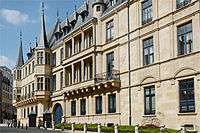
 Berg Castle, Luxembourg
Berg Castle, Luxembourg
From a morganatic marriage, contracted in 1868, descends a family, see Count of Merenberg, which in 1907 was declared non-dynastic. Had they not been excluded from the succession, they would have inherited the headship of the house in 1912.
Counts of Nassau-Wiesbaden-Idstein (1344–1728)
- 1344–1370: Adolph I
- 1370–after 1386: Gerlach II, Count of Nassau-Wiesbaden
- 1370–1393: Walram IV, Count of Nassau-Idstein; inherited Wiesbaden when Gerlach II died
- 1393–1426: Adolph II
- 1426–1480: John II
- 1480–1509: Philip, Count of Nassau-Idstein
- 1480–1511: Adolf III, Count of Nassau-Wiesbaden; inherited Idstein in 1509
- 1511–1558: Philip I
- 1558–1566: Philip II
- 1566–1568: Balthasar
- 1568–1596: John Louis I
- 1596–1599: John Philip, jointly with his brother John Louis II
- 1596–1605: John Louis II
- 1605–1627: Louis II
- 1627–1629: William Louis
- 1629–1677: John, Count of Nassau-Idstein, and (from 1651) in Wiesbaden, Sonnenberg, Wehen, Burg-Schwalbach and Lahr
- 1677–1721: George August Samuel (1688–1721)
- 1721–1723: Charles Louis
- 1723–1728: Frederick Louis, Count of Nassau-Ottweiler (1680–1728), and in Rixingen (1703–28), and Idstein (1721–1728), and in Wiesbaden, etc. (1723–28)
After Frederick Louis's death, Nassau-Wiesbaden-Idstein fell to Charles, Prince of Nassau-Usingen
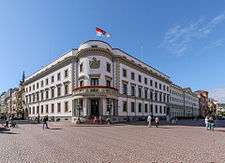
 Idstein Castle
Idstein Castle
Counts of Nassau-Saarbrücken (1429–1797)
- 1429–1472: John II
- 1472–1545: John Louis I
- 1545–1554: Philip II
- 1554–1574: John III
- 1574–1602: Philip IV, as Philip III of Nassau-Saarbrücken
- 1602–1625: Louis II, Count of Nassau-Saarbrücken and Ottweiler
- 1629–1640: William Louis, Count of Nassau-Saarbrücken and Ottweiler
- 1640–1642: Crato
- 1642–1659: John Louis II, Count of Nassau-Saarbrücken and (1659–80) in Ottweiler, Jungenheim, and Wöllstein
- 1659–1677: Gustav Adolph
- 1677–1713: Louis Crato
- 1713–1723: Charles Louis
- 1723–1728: Frederick Louis
- 1728–1735: Charles
- 1735–1768: William Henry, first Prince of Nassau-Saarbrücken
- 1768–1794: Louis
- 1794–1797: Henry Louis
- 1797-1812: Adolph II
After Henry Louis's death, Nassau-Saarbrücken fell to Charles William, Prince of Nassau-Usingen until Adolph came of age in 1805.
Princes of Nassau-Usingen (1659–1816)
- 1659–1702: Walrad, elevated to Prince
- 1702–1718: William Henry
- 1718–1775: Charles
- 1775–1803: Charles William
- 1803–1816: Frederick Augustus
In 1816, Nassau-Usingen merged with Nassau-Weilburg to form the Duchy of Nassau. See "Dukes of Nassau" above. The princely titles continued to be used, however, evidenced by the carrying of the title Prince of Nassau-Weilburg by the Grand Duke of Luxembourg. Following Frederick Augustus' death, the princely title was adopted (in pretense) by his half brother through an unequal marriage, Karl Philip. As head of the House in 1907, Wilhelm IV declared the Count of Merenberg non-dynastic; by extension, this would indicate that (according to Luxembourgish laws regarding the House of Nassau) this branch would assume the Salic headship of the house in 1965, following the death of the last male Count of Merenberg.[6]
 Usingen Castle
Usingen Castle
The Ottonian Line

- 1255–1290: Otto I, Count of Nassau in Siegen, Dillenburg, Beilstein, and Ginsberg
- 1290–1303: Joint rule by Henry, John and Emicho I, sons of Otto I
In 1303, Otto's sons divided the possessions of the Ottonian line. Henry received Nassau-Siegen, John received Nassau-Dillenburg and Emicho I received Nassau-Hadamar. After John's death. Nassau-Dillenburg fell to Henry.
Counts of Nassau-Dillenburg
- 1303–1328: John in Dillenburg, Beilstein and Herborn, and (from 1320) in Katzenelnbogen
- 1328–1343: Henry, from 1303 in Siegen, Ginsberg, Haiger, and the Westerwald, and from 1328 in Dillenburg, Herborn, and Beilstein
- 1343–1350: Otto II
- 1350–1416: John I
- Tetrarchy
- 1416–1420: Adolf
- 1420–1429: John III
- 1420–1442: Engelbert I
- 1420–1443: John II
- 1442–1451: Henry II
- 1448–1475: John IV
- 1475–1504: Engelbert II
- 1504–1516: John V
- 1516–1538: Henry III
- 1538–1559: William I
- 1559–1606: John VI
- 1606–1620: William Louis
- 1620–1623: George
- 1623–1662: Louis Henry, Prince of Nassau-Dillenburg from 1654
- 1662–1701: Henry
- 1701–1724: William II
- 1724–1739: Christian
In 1739, Nassau-Dillenburg fell to Nassau-Dietz, a.k.a. Orange-Nassau.
 Dillenburg Castle
Dillenburg Castle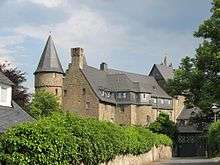
Counts of Nassau-Beilstein
In 1343, Nassau-Beilstein was split off from Nassau-Dillenburg.
- 1343–1388: Henry I
- 1388–1410: Henry II, jointly with his brother Reinhard
- 1388–1412: Reinhard
- 1412–1473: John I, jointly with his brother Henry III
- 1412–1477: Henry III
- 1473–1499: Henry IV
- 1499–1513: John II
- 1513–1561: John III, jointly with his brother Henry V
- 1513–1525: Henry V
After John III's death, Nassau-Beilstein fell back to Nassau-Dillenburg. It was split off again in 1607 for George, who inherited the rest of Nassau-Dillenburg in 1620.
 Beilstein Castle
Beilstein Castle
Counts and Princes of Nassau-Hadamar
- 1303–1334: Emicho I, Count in Driedorf, Esterau, and Hadamar, married Anna of Nuremberg
- 1334–1364: John, married Elisabeth of Waldeck
- ?-1412: Elisabeth, daughter of John, Countess of Nassau-Hadamar
- 1334–1359: Emicho II, son of Emicho I, married Anna of Dietz
- 1364–1369: Henry, son of John, Count of Nassau-Hadamar
- 1369–1394: Emicho III, son of John
After Emicho III's death, Nassau-Hadamar fell back to Nassau-Dillenburg.
In 1620, the younger line of Nassau-Hadamar was split off from Nassau-Dillenburg
- 1620–1653: John Louis, son of John VI of Nassau-Dillenburg, Prince from 1650
- 1653–1679: Maurice Henry, son of John Louis
- 1679–1711: Francis Alexander, son of Maurice Henry
In 1711, Nassau-Hadamar was divided between Nassau-Dietz, Nassau-Dillenburg, and Nassau-Siegen.
 Hadamar Castle
Hadamar Castle
Nassau-Siegen
The branch of Nassau-Siegen was a collateral line of the House of Nassau, and ruled in Siegen. The first Count of Nassau in Siegen was Count Henry, Count of Nassau in Siegen (d. 1343), the elder son of Count Otto I of Nassau. His son Count Otto II of Nassau ruled also in Dillenburg.
- 1303–1343: Henry, Count of Nassau in Siegen, Ginsberg, Haiger, and the Westerwald, and (1328–1343) in Dillenburg, Herborn, and Beilstein
In 1328, John of Nassau-Dillenburg died unmarried and childless, and Dillenburg fell to Henry of Nassau-Siegen. For counts of Nassau-Siegen in between 1343 and 1606, see "Counts of Nassau-Dillenburg" above.
In 1606 the younger line of Nassau-Siegen was split off from the House of Nassau-Dillenburg. After the main line of the House became extinct in 1734, Emperor Charles VI transferred the county to the House of Orange-Nassau.
 Siegen, Upper Castle
Siegen, Upper Castle
Counts and Princes of Nassau-Siegen
- 1606–1623 John I
- 1623–1638 John II
- 1638–1674 George Frederick
- 1674–1679 John Maurice
- 1679–1691 William Maurice
- 1691–1699 John Francis Desideratus
- 1699–1707 William Hyacinth
- 1707–1722 Frederick William Adolf
- 1722–1734 Frederick William II
In 1734, Nassau-Siegen fell to Nassau-Dietz, a.k.a. Orange-Nassau.
 Siegen, Lower Castle
Siegen, Lower Castle
Counts and Princes of Nassau-Dietz

- 1606–1632: Ernst Casimir
- 1632–1640: Henry Casimir I
- 1640–1664: William Frederick, Prince from 1650
- 1664–1696: Henry Casimir II of Nassau-Dietz, Prince of Nassau-Dietz
- 1696–1711: John William Friso, Prince of Nassau-Dietz (after 1702 also Prince of Orange)
 Diez Castle
Diez Castle- Oranienstein Castle, Diez
Orange-Nassau
The House of Orange-Nassau stems from the Ottonian Line. The connection was via Engelbert I, who offered his services to the Duke of Burgundy, married a Dutch noblewoman and inherited lands in the Netherlands, with the barony of Breda as the core of his Dutch possessions.
 Breda Castle
Breda Castle
The importance of the Nassaus grew throughout the 15th and 16th century. Henry III of Nassau-Breda was appointed stadtholder of Holland, Zeeland and Utrecht by Emperor Charles V in the beginning of the 16th century. Henry was succeeded by his son, René of Châlon-Orange in 1538, who was, as can be inferred from his name, a Prince of Orange. When René died prematurely on the battlefield in 1544 his possessions and the princely title passed to his cousin, William the Silent, a Count of Nassau-Dillenburg. By dropping the suffix name "Dillenburg" (of the Orange-Nassau-Dillenburg), from then on the family members called themselves "Orange-Nassau."
With the death of William III, the legitimate direct male line of William the Silent became extinct and thereby the first House of Orange-Nassau. John William Friso, the senior agnatic descendant of William the Silent's brother and a cognatic descendant of Frederick Henry, grandfather of William III, inherited the princely title and all the possessions in the low countries and Germany, but not the Principality of Orange itself. The Principality was ceded to France under the Treaty of Utrecht that ended the wars with King Louis XIV. John William Friso, who also was the Prince of Nassau-Dietz, founded thereby the second House of Orange-Nassau (the suffix name "Dietz" was dropped of the combined name Orange-Nassau-Dietz).
The Revolutionary and Napoleonic era was a tumultuous episode of the history of both the Ottonian and Walramian branches of the House of Nassau. France's dominance of the international order severely strained the House of Nassau's traditional strategy of international conflict resolution, which was to maintain links with all serious power-brokers through a dynastic network in the hope of playing one off against the other. Despite that both branches of the House of Nassau reinvigorated the dynastic network in the years of liberation, 1812-1814, the post-Napoleonic European order saw both branches set on different historical paths.[8]
After the post-Napoleonic reorganization of Europe, the head of House of Orange-Nassau gained the title "King/Queen of the Netherlands".
Princes of Orange
House of Orange-Nassau(-Dillenburg), first creation
- 1544–1584: William I, also Count of Katzenelnbogen, Vianden, Dietz, Buren and Leerdam and Lord of IJsselstein
- 1584–1618: Philip William, also Count of Nassau-Dillenburg, Count of Vianden, Buren and Leerdam and Lord of IJsselstein
- 1618–1625: Maurice, also Count of Nassau-Dillenburg, Count of Vianden, Buren and Leerdam and Lord of IJsselstein
- 1625–1647: Frederick Henry, also Count of Nassau-Dillenburg, Count of Vianden, Buren and Leerdam and Lord of IJsselstein
- 1647–1650: William II, also Count of Nassau-Dillenburg, Count of Vianden, Buren and Leerdam and Lord of IJsselstein
- 1650–1702: William III, also Count of Nassau-Dillenburg, Count of Vianden, Buren and Leerdam, Lord of IJsselstein and (from 1689) King of England, Scotland, and Ireland
In 1702, the Orange-Nassau-Dillenburg line died out and its possessions fell to the Nassau-Dietz line.
 Vianden Castle, Luxembourg
Vianden Castle, Luxembourg
House of Orange-Nassau(-Dietz), second creation
- 1702–1711: John William Friso, also Prince of Nassau-Dietz, Count of Vianden, Buren and Leerdam and Lord of IJsselstein
- 1711–1751: William IV, also Prince of Nassau-Dietz, Count of Vianden, Buren and Leerdam and Lord of IJsselstein
- 1751–1806: William V, also Prince of Nassau-Dietz, Count of Vianden, Buren and Leerdam and Lord of IJsselstein
- 1806–1815: William VI, also Prince of Fulda and Count of Corvey, Weingarten and Dortmund; in 1815 became King William I of the Netherlands

Kings and Queens of the Netherlands (from the House of Orange-Nassau-Dietz)
- 1815–1840: William I, also Duke and Grand Duke of Luxemburg and Duke of Limburg
- 1840–1849: William II, also Grand Duke of Luxemburg and Duke of Limburg
- 1849–1890: William III, also Grand Duke of Luxemburg and Duke of Limburg
- 1890–1948: Wilhelmina
Following German laws, the House of Orange-Nassau(-Dietz) has been extinct since the death of Wilhelmina (1962). Dutch laws and the Dutch nation do not consider it extinct.
- 1948–1980: Juliana
- 1980–2013: Beatrix
- 2013-present: Willem-Alexander

 Noordeinde Palace, Den Haag
Noordeinde Palace, Den Haag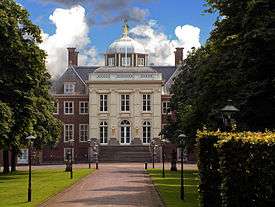 Huis ten Bosch, Den Haag
Huis ten Bosch, Den Haag
Family Tree
The following family tree is compiled from Wikipedia and the reference cited in the note[9]
| Dudo-Henry of Laurenburg (German: Dudo-Heinrich) (ca. 1060 – ca. 1123) was Count of Laurenburg in 1093 | |||||||||||||||||||||||||||||||||||||||||||||||
| Robert I of Nassau (German: Ruprecht) (ca. 1090 – ca. 1154) was from 1123 co-Count of Laurenburg later title himself 1st Count of Nassau | Arnold I of Laurenburg (died ca. 1148) | ||||||||||||||||||||||||||||||||||||||||||||||
| Robert II (German: Ruprecht) Count of Laurenburg (1154-1158)(died ca. 1159) | Walram I of Nassau (French: Valéran) (ca. 1146–1198) was the first (legally titled) Count of Nassau (1154-1198) | Henry (Heinrich) I co-Count of Nassau (1160 - August 1167) | Robert III, the Bellicose German: Ruprecht der Streitbare (died 1191) co-Count of Nassau (1160-1191) | ||||||||||||||||||||||||||||||||||||||||||||
| Henry (Heinrich) II, the Rich Count of Nassau (1180–1251) | Robert (Ruprecht) IV Count of Nassau (1198–1230) Teutonic Knight (1230–1240) | Herrmann (d after 3 December 1240) Canon of Mainz Cathedral | |||||||||||||||||||||||||||||||||||||||||||||
| Walram II of Nassau (ca. 1220 - 1276) the WALRAMIAN Branch present-day rulers of Luxembourg descend from him | Robert (Ruprecht) V d. before 1247 Teutonic Knight (1230–1240) | Otto I of Nassau (reigned ca. 1247 - 1290) the OTTONIAN branch the present-day rulers of the Netherlands descend from him | John (ca. 1230 - 1309) Bishop-Elect of Utrecht (1267–1290) | ||||||||||||||||||||||||||||||||||||||||||||
| Adolf (ca. 1255-1298) King of Germany (1292 - 1298) | Henry (d. 1343) Count of Nassau in Siegen | Emich (d. 7 June 1334) Count of Nassau in Hadamar extinct 1394 | John (d. 1328) Count Nassau in Dillenburg | ||||||||||||||||||||||||||||||||||||||||||||
| Ruprecht (+ 1304) | Gerlach I, Count of Nassau-Wiesbaden (bef 1288 +1361) | Walram III Count of Nassau-Wiesbaden | Otto II (c. 1305 – 1330/1331) Count of Nassau-Dillenburg | Henry (1307-1388) Count of Nassau-Beilstein ext. 1561 | |||||||||||||||||||||||||||||||||||||||||||
| Adolph (1307 +1370) Count of Nassau in Wiesbaden-Idstein ext 1605 | John I (1309 +1371) Count of Nassau-Weilburg | Rupert 'the Bellicose' (c. 1340 +1390) Count of Nassau-Sonnenberg | John I (1340 +1416) Count of Nassau-Dillenburg | ||||||||||||||||||||||||||||||||||||||||||||
| Philip I 1368 +1429) Count of Nassau in Weilburg,Saarbrücken, etc. | Adolph (1362 +1420) Count of Nassau-Dillenburg-Dietz | John II "The Elder" ( +1443) | Engelbert I (c. 1370/80 +1442) Count of Nassau, Baron of Breda founder of the Netherlands Nassaus | John III "The Younger" (+1430) Count of Nassau in Siegen | |||||||||||||||||||||||||||||||||||||||||||
| Philip II (1418 +1492) Count of Nassau-Weilburg | John II (1423 +1472) Count of Nassau-Saarbrücken ext. 1574 | John IV (Jan) (1410, +1475) Count of Nassau-Dillenburg-Dietz | Henry II (1414 +1450) Count of Nassau-Dillenburg | ||||||||||||||||||||||||||||||||||||||||||||
| John III (1441 +1480) Count of Nassau-Weilburg | Philip (1443-1471) Count of Nassau-Weilburg | Engelbert II the Valorious (1451 +1504) Count of Nassau and Vianden, Baron of Breda(fr), Lek, Diest, Roosendaal en Nispen and Wouw | John V (1455 +1516) Count of Nassau in Dillenburg,Siegen,Hadamar,Herborn,Vianden,Dietz | ||||||||||||||||||||||||||||||||||||||||||||
| From here descends the House of Nassau-Weilburg and the Grand Ducal Family of Luxembourg (see below also)' | From here descends the House of Orange-Nassau (see below also) | ||||||||||||||||||||||||||||||||||||||||||||||
House of Orange and Nassau
A summary family tree of the House of Orange-Nassau [10] from the joining of the house of Nassau-Breda/Dillenburg and the House of Châlon-Arlay-Orange to the end of the Dutch Republic is shown below. The family spawned many famous statesmen and generals, including two of the acknowledged "first captains of their age", Maurice of Nassau and the Marshal de Turenne.
Illegitimate Lines
Family tree Nassau-den Lek
| William I "the Silent" (1533-1584), Prince of Orange 1544, Stadholder of Holland, Zealand & Utrecht, assassinated by Spanish agent]] | |||||||||||||||||||||||||||||||||||||||||||||||||||||||||||||||||||||||||||||||||||||||||||||||||||||||
| Maurice (1567–1625), Prince of Orange,1618, Stadholder of Holland, Zealand, Utrecht, etc. | Margaretha van Mechelen (c. 1580 – 1662) | ||||||||||||||||||||||||||||||||||||||||||||||||||||||||||||||||||||||||||||||||||||||||||||||||||||||
| William of Nassau (1601–1627) "chevalier de Nassau", lord of de Lek | Louis of Nassau (1602– 1665) Lord of De Lek and Beverweerd 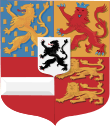 | Isabella van Hornes | |||||||||||||||||||||||||||||||||||||||||||||||||||||||||||||||||||||||||||||||||||||||||||||||||||||
| Willem Jonker van Nassau (1620-1679) | Maurits Lodewijk van Nassau (1631-1683) lord of den Lecq | William Adrian of Nassau (1632-1705) lord of Odijk | Elisabeth of Nassau (1633 – 1718) married Henry Bennet, 1st Earl of Arlington | Emilia (1635 – 1688) married Thomas Butler, 6th Earl of Ossory | Wilhelmina (~ 1638 - 1688) married Aelbert van Ruytenburgh | Henry of Nassau (1640– 1708) lord of Ouwerkerk count of Nassau, 1679 Master of the Horse to William III of England general, and commander of Dutch troops under Duke of Marlborough's | |||||||||||||||||||||||||||||||||||||||||||||||||||||||||||||||||||||||||||||||||||||||||||||||||
| William of Nassau (1654-) | Barbara of Nassau (1659-) | Alida of Nassau (1661-) | John of Nassau (1663-) | Maurits Lodewijk of Nassau (1670-1740) lord of den Lek | Lodewijk Adriaan of Nassau (1670-1742) lord of Odijk | Elisabeth Wilhelmina of Nassau (1671-1729) married her cousin Maurits Lodewijk II van Nassau-LaLecq | Charlotte of Nassau (1677-1715) married her cousin Willem Maurits van Nassau-Ouwerkerk | Isabella of Nassau (1668-1692) married Charles Granville, 2nd Earl of Bath | Lodewijk van Nassau (1669–1687) | Lucia van Nassau (1671–1673) | Henry of Nassau (1673–1754) 1st earl of Grantham | Cornelis van Nassau (1675–1712) lord of Woudenberg | Willem Maurits van Nassau (1679–1753) lord of Ouwerkerk married his cousin Charlotte of Nassau | Frans van Nassau (1682–1710) | Lucia Anna van Nassau (1684–1744) married Nanfan Coote, 2nd Earl of Bellomont | ||||||||||||||||||||||||||||||||||||||||||||||||||||||||||||||||||||||||||||||||||||||||
| Willem Hendrik van Nassau (1693-1762) lord of Ouderkerk | Anna Isabella van Nassau 1695-1765) married Mattheus Hoeufft Jr. | Hendrik Carel van Nassau (1696-1781) lord of Beverweerd and Odijk | Lodewijk Theodoor van Nassau 1701-1748) | Jan Nicolaas Floris van Nassau (1709-1782) lord of Ouderkerk | Alida Cornelia van Nassau (1705-170?) | Willem Adriaan II van Nassau (1704 – 1759) graaf van Nassau, lord of Odijk, vrijheer van Bergen (1708) | Henry of Nassau (1697 – 1718) Viscount Boston,1698 | Thomas of Nassau (1700 – 1730) Viscount Boston,1718 | Frances of Nassau (1711-1772) married Captain (later Lieutenant-Colonel) William Elliot of Wells | Emilia Mary of Nassau (1702-1712) | Henrietta de Nassau (1712-1747) married William Clavering-Cowper, 2nd Earl Cowper | William Henry (1710-1735) | Elisabeth (1712-) | Francoise Henriette (1711-) | |||||||||||||||||||||||||||||||||||||||||||||||||||||||||||||||||||||||||||||||||||||||||
| Catherina Elisabeth Wilhelmina van Nassau (1736-1777) | Lodewijk Theodoor II van Nassau (1741-1795) lord of de Lek, lord of Ouderkerk (1762-1773) | Jan Floris van Nassau (1751-1814) lord of de Lek, lord of Ouderkerk | Louise Suzanna van Nassau (1726 – 1803) married Frederik Christoffel graaf van Degenfeld-Schönburg (1721 – 1781) | Willem Lodewijk van Nassau (1727 - 1792) vrijheer van Bergen | Wigbold Adriaan van Nassau (1729 – 1797) lord of Odijk,etc. and vrijheer van Bergen | ||||||||||||||||||||||||||||||||||||||||||||||||||||||||||||||||||||||||||||||||||||||||||||||||||
| Jan Floris Hendrik Carel van Nassau (1782-1824) count of Nassau-la Lecq 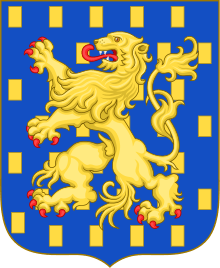 | |||||||||||||||||||||||||||||||||||||||||||||||||||||||||||||||||||||||||||||||||||||||||||||||||||||||
Family Tree Nassau-Zuylestein
| William I "the Silent" (1533-1584), Prince of Orange 1544, Stadholder of Holland, Zealand & Utrecht, assassinated by Spanish agent]] | |||||||||||||||||||||||||||||||||||||||||||||||||||||||||||||||||||||||||||||||
| Frederick Henry (1584–1647) Prince of Orange, 1625, Stadtholder of Holland, Zeeland, & etc. | Margaretha Catharina Bruyns ((1595–1625) | ||||||||||||||||||||||||||||||||||||||||||||||||||||||||||||||||||||||||||||||
| Frederick of Nassau (1624–1672) Lord of Zuylestein  | Mary Killigrew (1627-) daughter of Sir William Killigrew | ||||||||||||||||||||||||||||||||||||||||||||||||||||||||||||||||||||||||||||||
| William van Nassau (1649 – 1708) 1st Earl of Rochford | Hendrik van Nassau (ca 1650 – 1673) Heer van Leersum | ||||||||||||||||||||||||||||||||||||||||||||||||||||||||||||||||||||||||||||||
| Anna Nassau de Zuylestein (ca 1681 – 1701) | William Nassau de Zuylestein (1682-1710) 2nd Earl of Rochford | Frederik Nassau de Zuylestein (1684-1738) heer van Zuylestein, Leersum en Waayenstein 1709-1738, 3rd Earl of Rochford,1710 | Maurits van Nassau-Zuylestein (1685 – 1720) Colonel, English Army | Maria van Nassau-Zuylestein (1687 – 1765) married baron Godard Adriaan van Reede (16xx – 1730), heer van Herreveld and 1st Earl of Athlone, son of Godard van Reede heer van Ginckel (1644-1703) | Elizabeth van Nassau-Zuylestein (1688 – ca 1720) | Henriette (1688 – 1759) married Frederik Christiaan van Reede, baron van Reede, 2nd Earl of Athlone | Frederik Hendrik (Henry) van Nassau-Zuylestein (1692? – 1740) | ||||||||||||||||||||||||||||||||||||||||||||||||||||||||||||||||||||||||
| William Nassau de Zuylestein (1717–1781) 4th Earl of Rochford British courtier, diplomat and statesman illeg. desc. | Richard Savage Nassau de Zuylestein (1723 – 1780) Member of Parliament, 1747-1754, 1774-1780 | ||||||||||||||||||||||||||||||||||||||||||||||||||||||||||||||||||||||||||||||
| Frederick Nassau[14] ·
[15] (1771-1857) Master of St. Osyth Priory | Ann[14] · [15] (1773/4-1848) | Mary[14] · [15] (1762/3-1850) | William Henry Nassau (1754–1830) 4th Earl of Rochford | George Richard Savage Nassau (1758–1823) bibliophile | Lucy Nassau (1752–1830) | ||||||||||||||||||||||||||||||||||||||||||||||||||||||||||||||||||||||||||
| William Frederick Nassau[14] · [15] (1798-1857) Master of St. Osyth Priory | John Augustus Nassau[14] · [15] (1806-?) | Ann Nassau[14] · [15] (1800-1868) | |||||||||||||||||||||||||||||||||||||||||||||||||||||||||||||||||||||||||||||
| Elizabeth Catherina Nassau[14] · [15] (1827-1926) Mistress of St. Osyth Priory married John Roberts Kirby | Eliza Nassau[14] · [15] (1833-1912) | Rochford Augustus Nassau[14] · [15] (1853-1902) | |||||||||||||||||||||||||||||||||||||||||||||||||||||||||||||||||||||||||||||
| Frederik "Frank" Rochford Nassau[14] · [15] (1889-1959) | Herbert Arthur Nassau[14] · [15] (1892-1932) | Harold Charles Nassau[14] · [15] (1894-1895) | Letta Mary Nassau[14] · [15] (1884-+young) | Nellie Nassau[14] · [15] (?-+young) | Ethel Violet Nassau[14] · [15] (1896 - ) married Frederick Savage | ||||||||||||||||||||||||||||||||||||||||||||||||||||||||||||||||||||||||||
| Doris Elsie Nassau[14] · [15] (1915-1952) married Stanley Philip Painter | Frederik (Freddie) Herbert Nassau[14] · [15] (1919-1990) one daughter [16] | Herbert John Nassau[14] · [15] (1920-1969) 2 daughters[17] | |||||||||||||||||||||||||||||||||||||||||||||||||||||||||||||||||||||||||||||
Family Tree Nassau-Grimhuizen
| William I "the Silent" (1533-1584), Prince of Orange 1544, Stadholder of Holland, Zealand & Utrecht, assassinated by Spanish agent]] | Eva Elincx | ||||||||||||||||||||||||||||||||||||||||||||||||||||||||||||||||||||||||||||||||
| Justinus van Nassau (1559 – 1631) Admiral & General, Gov of Breda 1601-1625 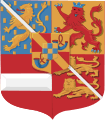 | Anne, Baronesse de Mérode (1567 - 1634) | ||||||||||||||||||||||||||||||||||||||||||||||||||||||||||||||||||||||||||||||||
| William (1603 - 1638) jonker van Nassau, heer van Grimhuizen | Louise Henriëtte van Nassau (1604 - bet 1637/45) married Henry Philip Herbert lt. col. in Dutch Army, 1 son, Philips Henry Herbert (1634-1657) | Philips van Nassau (1605 - between 1672/76) jonker van Nassau, heer van Grimhuizen, Hoekelom en Wijchen | |||||||||||||||||||||||||||||||||||||||||||||||||||||||||||||||||||||||||||||||
| Justinus II van Nassau (1633 – 1658) Jonker van Nassau heer van Grimhuizen | Justina van Nassau (1635 – 1721) married George van Cats (1632 – na 1676) heer van Cats, Coulster en Schagen | Anna Justina van Nassau (1638 – 1721) married Willem Adriaan II van Horne graaf van Horne, baron van Kessel en heer van Batenburg | Philips van Nassau died young | Anna Margaretha van Nassau (1634 - 1676) married (1) Diederik Schenk van Nydeggen heer van Blijenbeek, Afferden en Grubbenvorst married (2) Johan Gerard van Oostrum heer van Moersbergen, Cattenbroek en Zeist, col in Dutch Army, 2 daughters. | |||||||||||||||||||||||||||||||||||||||||||||||||||||||||||||||||||||||||||||
House of Nassau-Weilburg
Compiled from Wikipedia and:[18][19]
| For ancestors of the House of Nassau-Weilburg (House of Nassau family tree)' | |||||||||||||||||||||||||||||||||||||||||||
| John III (1441 +1480) Count of Nassau-Weilburg | |||||||||||||||||||||||||||||||||||||||||||
| Louis I (1473 +1523) Count of Nassau-Weilburg | |||||||||||||||||||||||||||||||||||||||||||
| Philip III (1504 +1559) Count of Nassau-Weilburg | |||||||||||||||||||||||||||||||||||||||||||
| Albert (1537 +1593) Count of Nassau-Weilburg | Philip IV (1542 +1602) Count of Nassau-Weilburg in Saarbrucken | ||||||||||||||||||||||||||||||||||||||||||
| Louis II (1565 +1627) Count of Nassau-Weilburg in Ottweiler | William (1570–1597) Count of Nassau-Weilburg in Weilburg | John Casimir (1577 +1602) Count of Nassau-Weilburg in Gleiberg | |||||||||||||||||||||||||||||||||||||||||
| William Louis (1590 +1640) Count of Nassau-Saarbrücken | John (1603 +1677) Count of Nassau-Idstein Counts of Nassau-Idstein ext.1721 | Ernest Casimir (1607 +1655) Count of Nassau-Weilburg | |||||||||||||||||||||||||||||||||||||||||
| John Louis (1625 +1690) Count of Nassau-Ottweiler ext. 1728 | Gustav Adolph (1632 +1677) Count of Nassau-Saarbrücken ext. 1723 | Walrad (1635 +1702) Count & Prince of Nassau-Usingen ext. 1816 | Frederick (1640 +1675) Count of Nassau-Weilburg | ||||||||||||||||||||||||||||||||||||||||
| John Ernst (1664 +1719) Count & Prince of Nassau-Weilburg | |||||||||||||||||||||||||||||||||||||||||||
| Charles August (1685 +1753) Prince of Nassau-Weilburg | Charles Ernst (1689–1709) Prince of Nassau-Weilburg | ||||||||||||||||||||||||||||||||||||||||||
| Charles Christian (1735 +1788) Prince of Nassau-Weilburg | Princess Carolina of Orange-Nassau (1743 +1787) | ||||||||||||||||||||||||||||||||||||||||||
| Frederick William (1768 +1816) Prince of Nassau-Weilburg | |||||||||||||||||||||||||||||||||||||||||||
| William (1792 +1839) Duke of Nassau | |||||||||||||||||||||||||||||||||||||||||||
| Adolphe (1817 +1905) Duke of Nassau 1839-1866 Grand Duke of Luxembourg 1890-1905 | |||||||||||||||||||||||||||||||||||||||||||
| Grand Ducal Family of Luxembourg | |||||||||||||||||||||||||||||||||||||||||||
The Grand-Ducal Family of Luxembourg
| Adolphe (1817–1905) Duke of Nassau 1839-1866 Grand Duke of Luxembourg 1890-1905 | Princess Adelheid-Marie of Anhalt-Dessau | ||||||||||||||||||||||||||||||||||||||||||||
| William IV (1852–1912) Grand Duke of Luxembourg | Infanta Marie Anne of Portugal | ||||||||||||||||||||||||||||||||||||||||||||
| Marie-Adélaïde (1894–1924) Grand Duchess of Luxembourg | Charlotte (1896–1985) Grand Duchess of Luxembourg 1919–1964 | Prince Felix of Bourbon-Parma | |||||||||||||||||||||||||||||||||||||||||||
| Jean (1921–) Grand Duke of Luxembourg 1964–2000 | Princess Joséphine-Charlotte of Belgium | Prince Charles of Luxembourg | |||||||||||||||||||||||||||||||||||||||||||
| Archduchess Marie-Astrid of Austria | Henri (1955–) Grand Duke of Luxembourg 2000 small arms grand arms | Maria Teresa Mestre | Prince Jean of Luxembourg | Princess Margaretha of Liechtenstein | Prince Guillaume of Luxembourg | ||||||||||||||||||||||||||||||||||||||||
| Guillaume Hereditary Grand Duke of Luxembourg | Prince Félix of Luxembourg | Prince Louis of Luxembourg | Princess Alexandra of Luxembourg | Prince Sébastien of Luxembourg | |||||||||||||||||||||||||||||||||||||||||
See also
References
- ↑ Grand Duchess Charlotte abdicated in 1964, but she died in 1985
- ↑ Clotilde Countess of Nassau-Merenberg is the last patrilineal descendant of the House of Nassau though she descends from a family considered to be non-dynastic
- ↑ Family tree of the early House of Nassau, retrieved on 2009-01-22.
- ↑ Table 11, Page 23 and note on page 151, quoted at Genealogy of the Middle Ages, retrieved on 2009-01-23
- ↑ https://www.academia.edu/25907933/The_House_of_Nassau_between_France_and_Independence_1795_1814_Lesser_Powers_Strategies_of_Conflict_Resolution_Dynastic_Networks
- ↑ Pütter, Johann Stephan. Primae lineae juris privati Principum speciatim Germanicae. Göttingen, 1789 (3rd ed.).
- ↑ "Pałac Gozdzkich - de Nassau". www.warszawa1939.pl (in Polish). Retrieved 2009-03-23.
- ↑ https://www.academia.edu/25907933/The_House_of_Nassau_between_France_and_Independence_1795_1814_Lesser_Powers_Strategies_of_Conflict_Resolution_Dynastic_Networks
- ↑ Louda, Jiri; Maclagan, Michael (December 12, 1988), "Netherlands and Luxembourg, Table 33", Heraldry of the Royal Families of Europe (1st (U.S.) ed.), Clarkson N. Potter, Inc.;
- ↑ "Official Website of the Dutch Royal House". Rijksvoorlichtingsdienst (RVD), The Hague, the Netherlands. Retrieved 2013-04-30.
- ↑ Rietstap, Johannes Baptist (1875). Handboek der Wapenkunde. the Netherlands: Theod. Bom. p. 348.
Prins FREDERIK: Het koninklijke wapen, in 't shcildhoofd gebroken door een rooden barensteel, de middelste hanger beladen met een regtopstaanden goud pijl.
- ↑ Junius, J.H. (1894). Heraldiek. the Netherlands: Frederik Muller. p. 151.
...de tweede oon voert het koninklijk wapen gebroken door een barensteel van drie stukken met een zilveren pijl.
- ↑ Junius, J.H. (1894). Heraldiek. the Netherlands: Frederik Muller. p. 151.
...is het wapen afgebeeld van de oudste dochter van den Koning der Nederlanden. De barensteel is van keel en beladen met een gouden koningskroon.
- 1 2 3 4 5 6 7 8 9 10 11 12 13 14 15 16 17 18 MAREK, Miroslav (2012). "GENEALOGY.EU, The House of Nassau". GENEALOGY.EU. Retrieved 2016-11-18.
- 1 2 3 4 5 6 7 8 9 10 11 12 13 14 15 16 17 18 "Ancestry.com". ANCESTRY.COM. 2016. Retrieved 2016-11-18.
- ↑ Note: still living, probably not appropriate to post
- ↑ Note: still living, probably not appropriate to post
- ↑ Louda, Jiri; Maclagan, Michael (December 12, 1988), "Netherlands and Luxembourg, Table 33", Heraldry of the Royal Families of Europe (1st (U.S.) ed.), Clarkson N. Potter, Inc.;
- ↑ https://www.academia.edu/25907933/The_House_of_Nassau_between_France_and_Independence_1795_1814_Lesser_Powers_Strategies_of_Conflict_Resolution_Dynastic_Networks
Sources
- Genealogy of the Middle Ages - House of Nassau
- Nassau-info.de
- Marek, Miroslav. "Nassau Genealogies". Genealogy.EU.
- Hay, Mark Edward, 'The House of Nassau between France and Independence, 1795–1814: Lesser Powers, Strategies of Conflict Resolution, Dynastic Networks', The International History Review, 38/3 (2016), 482-504 [1]
External links
- ↑ https://www.academia.edu/25907933/The_House_of_Nassau_between_France_and_Independence_1795_1814_Lesser_Powers_Strategies_of_Conflict_Resolution_Dynastic_Networks


